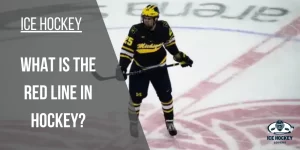Hockey Plus Minus: What Does Plus Minus Mean in Hockey?

As a hockey fan, you must know a few things to enjoy a hockey game and understand what is going on. One of these things is understanding the players scoring stats. If you look closely at the stats chart, you will find the +/- (plus/minus) symbol. Ever wondered what this symbol indicates?
So, what does plus minus mean in hockey? In ice hockey, the plus-minus stats reveal the number of times a player is present on the ice when his team scores a goal or the other team scores a goal against his team. A positive sign indicates that the player’s team has scored more goals with him on the ice, while a negative sign indicates the other team’s goals are higher.
Let’s break down hockey plus-minus and figure out how plus-minus is calculated and what is a good plus-minus in hockey. Moreover, who are the NHL plus-minus leaders?
Table of Contents
How is plus-minus calculated in the NHL?
The plus/minus stat has some controversies; it still has importance in the NHL. All the players have their plus-minus ratings. The officials determine the scoring that happens with that player on the ice.

The calculation is simple. If the player’s team scores during even-strength or shorthanded with him playing on the ice, he gets a single point added to the plus/minus score. On the other hand, if the other team scores an even-strength or shorthanded goal, they get the point subtracted from their plus-minus score.
When to give a plus or minus sign?
- A player on the ice will get a plus (+) sign when his team scores a goal either at even strength or on shorthanded.
- A player on the ice will get a (-) sign for a goal against if a team is on the power play or shorthanded.
- A player will neither have a plus nor minus sign when there is a powerplay goal. The powerplay team’s players will not get a plus sign on scoring a goal. Also, the shorthanded team’s players trying to kill the penalty but not succeed will not get a minus sign.
- Players on the ice will get both plus and minus when there is an empty net goal against them because, at that time, this is still regarded as even strength, except a team on power play scores an empty net goal.
How vital is plus-minus in hockey?

It is essential to calculate the plus/minus statistic, and it serves a purpose. It helps the players and the team know if they are good at defense. Players who cannot score well against the other team or cannot stop them from scoring do not have good plus-minus stats. But it is also important to remember that it is only a stat that depends on the game’s situation.
What are hockey scenarios to keep in mind for this stat?
Knowing that the plus-minus stats count when the goal is at even strength or shorthanded is essential. Points are not added or subtracted to the plus-minus total in the power play, shootout goals, or penalty shots. But the empty net goals add and subtract from this total.
What are examples where the stat falls flat?
There are some instances in which this stat does not work correctly and, therefore, has some controversy.
For example, the players serving the penalty do not have high plus/minus values, while the players on the power play may have.
Similarly, if the third or fourth-line players of a team’s roster play against the front-line players of the opponent, their plus and minus ratings will be lower because the skill level is not in balance.
When did the NHL adopt the plus-minus score?

We saw the plus-minus score calculation for the first time in ice hockey history in the 1950s. The credit goes to the Montreal Canadiens since they were the first to calculate it. Other teams also started calculating these stats after them. Finally, the NHL adopted this stat officially in 1967-68.
What’s a good plus-minus Value?
A positive plus-minus value is a plus for a player’s statistics because it shows that his team scored more goals with him on the ice. It also means the player has good defensive abilities and does not allow more goals to the opponent.
But according to some, a neutral ranking is also good because it means the player can keep the goals in check and protect his team’s score. So, such players can also help their team in winning the game.
NHL All-Time Plus-Minus Leaders
The top three players with the best ranking in plus-minus are the defensemen. On the other hand, three players out of the top ten are forwards. According to the hockey reference best plus-minus in NHL history are:
| Rank | Player Name | Years | +/- |
| 1 | Larry Robinson | 1972-92 | +722 |
| 2 | Bobby Orr | 1966-79 | +582 |
| 3 | Ray Bourque | 1979-01 | +527 |
| 4 | Wayne Gretzky | 1979-99 | +520 |
| 5 | Bobby Clarke | 1969-84 | +507 |
NHL All-Time Worst Plus-Minus
Here are the top 5 NHL all-time worst plus-minus leaders:
| Rank | Player Name | Game Played | +/- |
| 1 | Bob Stewart | 575 | -257 |
| 2 | Don Lever | 1020 | -248 |
| 3 | Gary Croteau | 684 | -234 |
| 4 | Dave Babych | 1195 | -216 |
| 5 | Leo Boivin | 728 | -212 |
NHL Plus-Minus Leaders 2022-23
Here are the top 5 NHL plus-minus leaders for the 2022-23 season:
| Rank | Player Name | Team | Game Played | +/- |
| 1 | Hampus Lindholm | BOS | 33 | +27 |
| 2 | Joe Pavelski | DAL | 35 | +22 |
| 3 | Tomas Tatar | NJD | 34 | +20 |
| 4 | Patrice Bergeron | BOS | 33 | +19 |
| 5 | Michael Bunting | TOR | 34 | +19 |
Comparing a +/- Stat to Other Hockey Stats
If you want to know a player’s importance to a team in actuality, don’t rely on only one stat. Compare all the standard statistics. For example, shooting percentage and ice time are statistics that can completely define a player’s performance on the ice compared with the plus or minus. Similarly, it is also essential to know a player’s high or low assists.
Frequently Asked Questions
Do power plays to impact a +/- score?
One of the frequently asked questions about the plus-minus stats is; Do the power plays impact this score? The answer is no. Power plays do not affect the plus-minus score, but if the opponent shorthanded team goals, it will impact their stats.
Conclusion
In conclusion, plus-minus statistics are another form that can determine if a player is defensively or offensively responsible. A high rating in these stats is good for the players because they decide how many goals were scored on the ice. But comparing these with other statistics is also helpful for a complete picture of performance.
Related Posts:

Who is Austin Taylor?
Meet Austin Taylor, your go-to source for everything ice hockey! With a passion for the sport that’s as deep as the ice itself, Austin Taylor brings you concise, expert insights and nitty-gritty details on all things hockey. From gear reviews to strategy breakdowns, Austin Taylor is your trusted guide to navigating the exhilarating world of ice hockey. Get ready to lace up your skates and dive into the game with Austin Taylor as your ultimate companion.





